Training and Test sets
Contents
Training and Test sets¶
We have seen how detrimental overfitting can be to predictive models. Models biased for the sample they were fitted (trained) on might not capture much form the underlying true relationship. The next step is to evaluate, how much predictive performance we have when we rule out the effect of overfitting. There is a very straightforward solution: we can simply obtain predictions with our fitted model on data that it haven’t seen before.
Below, we re-compute two models that we have fitted in the previous section and obtain more data that the models haven’t seen before and use it for testing their unbiased predictive performance.
Let’s install and import some libraries.
Here we start using a new package> scikit-learn.
Note
Scikit-learn is the leading package for “classical” machine learning, with an excellent documentation and a very active community. It offers a great start into predictive modelling and machine learning for people with a broad spectrum of background.
!pip install scikit-learn
import numpy as np
import pandas as pd
import seaborn as sns
from sklearn.linear_model import LinearRegression
Requirement already satisfied: scikit-learn in /home/tspisak/src/RPN-signature/venv/lib/python3.8/site-packages (0.24.2)
Requirement already satisfied: joblib>=0.11 in /home/tspisak/src/RPN-signature/venv/lib/python3.8/site-packages (from scikit-learn) (1.0.1)
Requirement already satisfied: threadpoolctl>=2.0.0 in /home/tspisak/src/RPN-signature/venv/lib/python3.8/site-packages (from scikit-learn) (2.2.0)
Requirement already satisfied: scipy>=0.19.1 in /home/tspisak/src/RPN-signature/venv/lib/python3.8/site-packages (from scikit-learn) (1.7.1)
Requirement already satisfied: numpy>=1.13.3 in /home/tspisak/src/RPN-signature/venv/lib/python3.8/site-packages (from scikit-learn) (1.19.5)
WARNING: You are using pip version 21.2.4; however, version 22.0.3 is available.
You should consider upgrading via the '/home/tspisak/src/RPN-signature/venv/bin/python -m pip install --upgrade pip' command.
Now we load our example dataset, but in two non-overlapping pieces. The first 80 participants are loaded into df_train. Then, another 80 are loaded into df_test.
df = pd.read_csv("https://raw.githubusercontent.com/pni-lab/predmod_lecture/master/ex_data/IXI/ixi.csv")
train = df.index[:80]
test = df.index[80:160]
features = df.columns[2:]
target = 'Age'
Train overfitted models¶
First, we fit a linear model called model_1, with one single predictor, the right superior frontal cortex volume.
This time we use scikit-learn’s implementation of linear regression (instead of the statsmodels’ function).
Scikit-learn’s LinearRegression() is a minimalistic implementation that is, in many ways, optimized for use in machine learning.
It doesn’t even provide p-values. But we won’t miss them…
Note that we use only the “training sample” (df.loc[train, target]) to fit the model.
See also
Wonder, what .loc means in the code? It’s just the syntax for dataframe indexing/slicing in 2-dimensions (rows and columns). See the pandas documentation for more detail.
model_1 = LinearRegression().fit(y=df.loc[train, target], X=df.loc[train, ['rh_superiorfrontal_volume']])
yhat = model_1.predict(df.loc[train, ['rh_superiorfrontal_volume']])
mae_model_1_train = np.mean(np.abs(df.loc[test, target] - yhat))
print('MAE:', mae_model_1_train)
sns.regplot(x=df.loc[train, target], y=yhat)
MAE: 12.7710554136974
<AxesSubplot:xlabel='Age'>
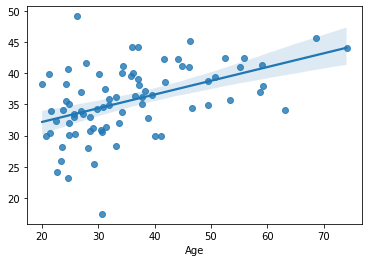
We have computed a simple measure of how much the model predictions differ form the actual data: the mean absolute error (MAE):
Now, we train model_2, which takes use of all available predictors.
model_2 = LinearRegression().fit(y=df.loc[train, target], X=df.loc[train, features])
yhat = model_2.predict(df.loc[train, features])
mae_model_2_train = np.mean(np.abs(df.loc[train, target] - yhat))
print('MAE:', mae_model_2_train)
sns.regplot(x=df.loc[train, target], y=yhat)
MAE: 3.2574285440159656
<AxesSubplot:xlabel='Age'>
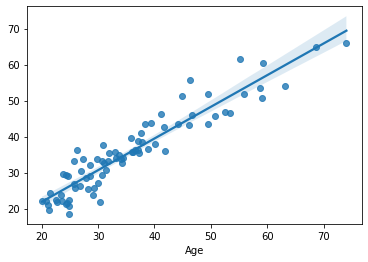
Finally, we train model_3, a dummy model with random features that are guaranteed to be independent form the target.
rng = np.random.default_rng(seed = 42)
df_random = pd.DataFrame(rng.normal(loc=np.mean(df.loc[train, features]), scale=np.std(df.loc[train, features]), size=(len(train), len(features))))
model_3 = LinearRegression().fit(y=df.loc[train, target], X=df_random)
yhat = model_3.predict(df_random)
mae_model_3_train = np.mean(np.abs(df.loc[train, target] - yhat))
print('MAE:', mae_model_3_train)
sns.regplot(x=df.loc[train, target], y=yhat)
MAE: 3.9538865240948704
<AxesSubplot:xlabel='Age'>
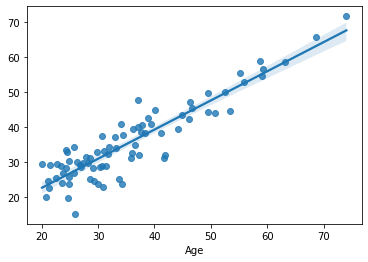
We see the same picture as in the previous section: adding more predictors increases performance on the training set, even if the predictors are just random noise. We also already know that this is due to overfitting the training set.
But how much do these models overfit? Here comes the moment if justice!
Test overfitted models on unseen data¶
Let’s test all models on the test set, i.e. on data that the model haven’t seen during training.
yhat = model_1.predict(df.loc[test, ['rh_superiorfrontal_volume']])
mae_model_1_test = np.mean(np.abs(df.loc[test, target] - yhat))
print('MAE:', mae_model_1_test)
sns.regplot(x=df.loc[test, target], y=yhat)
MAE: 10.51406018565751
<AxesSubplot:xlabel='Age'>
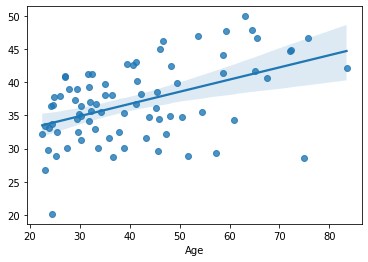
yhat = model_2.predict(df.loc[test, features])
mae_model_2_test = np.mean(np.abs(df.loc[test, target] - yhat))
print('MAE:', mae_model_2_test)
sns.regplot(x=df.loc[test, target], y=yhat)
MAE: 14.418876799838511
<AxesSubplot:xlabel='Age'>
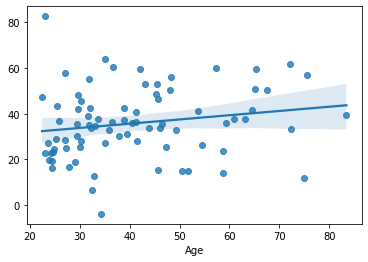
yhat = model_3.predict(df.loc[test, features])
mae_model_3_test = np.mean(np.abs(df.loc[train, target] - yhat))
print('MAE:', mae_model_3_test)
sns.regplot(x=df.loc[test, target], y=yhat)
MAE: 24.69969184046377
<AxesSubplot:xlabel='Age'>
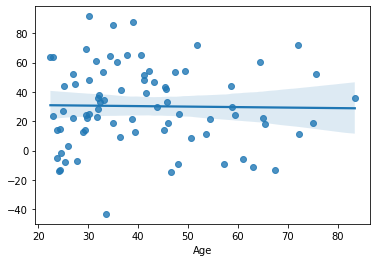
Let’s summarise the results!
summary = pd.DataFrame([[mae_model_1_train, 'model 1', 'train'],
[mae_model_1_test, 'model 1', 'test'],
[mae_model_2_train, 'model 2', 'train'],
[mae_model_2_test, 'model 2', 'test'],
[mae_model_3_train, 'model 3', 'train'],
[mae_model_3_test, 'model 3', 'test']], columns=['MAE', 'model', 'sample'])
sns.barplot(x='model', y='MAE', hue='sample', data=summary)
<AxesSubplot:xlabel='model', ylabel='MAE'>
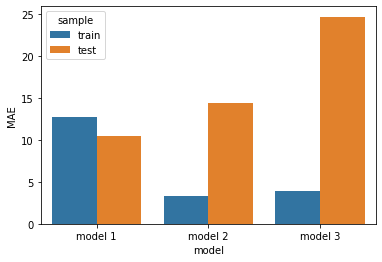
What we see that performance on the training and test sets can be strikingly different.
The simplest model (model_1) with a single predictor performed best on the test set, actually even slightly better (lower error) than on the training set, implying a negligible level of overfitting in case of this model.
The other two models were much more complex, i.e. they had a lot more parameters to (over)fit. Indeed, while they seemed to perform significantly better than model_1 on the trainig set, their performance strikingly dropped on the test set. These models heavily overfitted the training data.
Even though it overfitted the training sample, model_2 has captured some generalizable knowledge, as well. On the other hand, our pure-noise model (model_3), as expected, didn’t perform better than chance on the test set and all its performance on the training set has to be attributed to overfitting.
Excercise 3.3
Does a simple linear model overfit with your own dataset, too? Try it out in Google Colab!
Train-test split¶
Holding out a test set (or measuring new data post model training) is a very common practice in predictive modelling and machine learning, providing a very straightforward solution for ruling out the effect of overfitting and to obtain unbiased estimates of predictive performance.
However, due to the costs of the data acquisition, holding out a large number of participants solely for testing is often a luxury. In the next section we will see, how cross-validation can help in getting out the most of our data when training predictive models.
